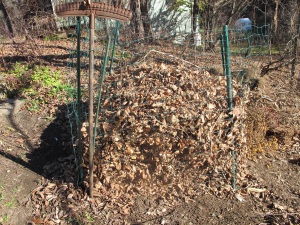Leaves and Compost and Mulch, Oh My!
Even if you raked your leaves in October, you probably have some more to clean up now. I do. Of course I was off gallivanting for much of October and hadn’t done any raking until recently. Still, trees like oaks and apples are still dropping leaves.
When I was a boy in Connecticut, my gardening Grampy would take the train or a bus from Spencer, Massachusetts each fall to visit us. In addition to getting some homemade apple pie and seeing his grandchildren, he came to help us rake the leaves. We lived in the country with close to an acre of lawn, I’d estimate, surrounded by a mixed hardwood forest. A lot of leaves fell –or blew- onto that lawn.
If you are of a certain age, you remember that back in the 1950’s there were no blue plastic tarps. We only had a wheelbarrow – one we called “the leaf cart” – to carry off many bushels of leaves. But Grampy was a tailor by trade, and made something to spread out on the lawn. He sewed together old sheets or bedspreads to make a large square of cloth, and brought it with him when he came each year. We raked the leaves onto that and when it was full, he drew the 4 corners together. Then, like Santa about to go down a chimney, he loaded it onto his back and carried it away.
Those leaves slowly broke down and made some of the most delicious compost you could ever imagine. Dark in color, it was loved by earthworms and was a great addition to our vegetable garden, flower pots and flower beds a few years after the leaves were collected.
It makes sense that leaves would make great compost. Trees mine the soil, bringing up minerals that end up in leaves. And, by the miracle of photosynthesis, trees make sugars and carbohydrates that build plant bodies. Re-using these elements is the original recycling. Trees have been dropping leaves and letting the bacteria, fungi and fauna of the forest break them down and re-use the elements for ages. Collecting them for use in our gardens is our way of capitalizing on a natural process.
Long ago I visited garden writer Sydney Eddison in her Connecticut garden. It was towards the end of a prolonged summer drought, one so bad that mature oaks were dying. There was a watering ban, but her flower gardens were thriving and, when I felt the soil, it was lightly damp. I asked her how she did it.
It was simple, she said. For 30 years her husband, Martin, had collected leaves each fall, running them over with a lawnmower and bagging them. He saved them in the barn, and in the spring Sydney spread out the chopped leaves and lawn grass around her perennials after they appeared. This mulch kept down weeds, attracted earthworms and enriched the soil. And it held moisture.
I use my leaves in the garden, too, though I do not bother bagging them. Most I spread over my mounded, raised vegetable beds after they have been weeded and re-shaped in the fall. They keep weeds from getting an early start, and keep out weed seeds that are blowing in the wind. Because they have been chopped, they don’t blow around much, and certainly not after a rain.
My neighbors, Susan and Joel Kinne, collect their leaves and put them in a bin they made with steel fence posts and wire mesh. It is about 4 feet on a side, and 4 feet high. I’ve seen the compost they have harvested from their bin, and it is gorgeous. Any self-respecting plant would love some in its soil. According to Joel, it takes between 2 and 3 years to go from leaf to compost, and they never bother turning the pile or doing anything else for the leaves.
I take my food scraps and the leaves and stems of kale, carrots and other veggies and toss it in a bin I made from old wood pallets. I have to admit I rarely bother to collect the compost – it is more a way of keeping vegetable matter out of the waste stream than making compost. But recently I took off one side of the bin and dug out some of the material from deep under this years’ additions.
I was amazed at the number of earthworms in the top layers – this year’s waste. There hundreds, perhaps thousands. Wriggling and squirming, small ones, medium sized ones. That’s good. They eat the food and their waste, called castings, is high in nitrogen and other minerals necessary for plant growth. More importantly, they are good sources of materials that create good tilth and texture in soil.
Deep down I harvested a bucket of black compost. It was fluffy, despite being pressed down by many pounds of matter above it. I could see bits of eggshell, but everything had been processed. I’ll mix it 50-50 with potting soil and use it to replant houseplants, giving them a fresh infusion of nutrients.
When I was a kid we jumped in the piles of leaves Grampy collected, but I think now, as a (considerably) heavier person, doing so might lead to broken bones. Still, I treasure those memories … and my leaf compost.
Henry is a UNH Lifetime Master Gardener the author of 4 gardening books. His website is www.Gardening-guy.com.




